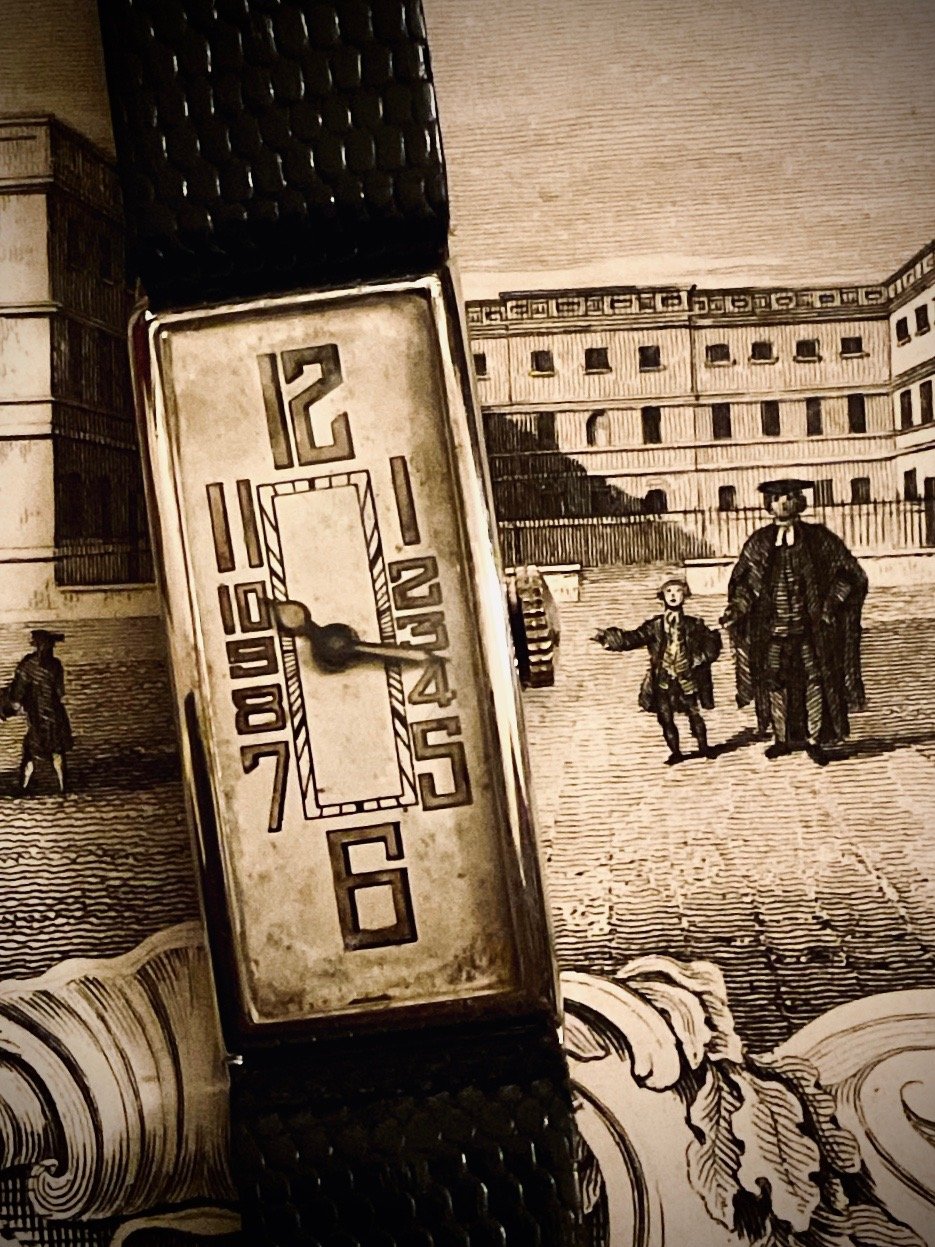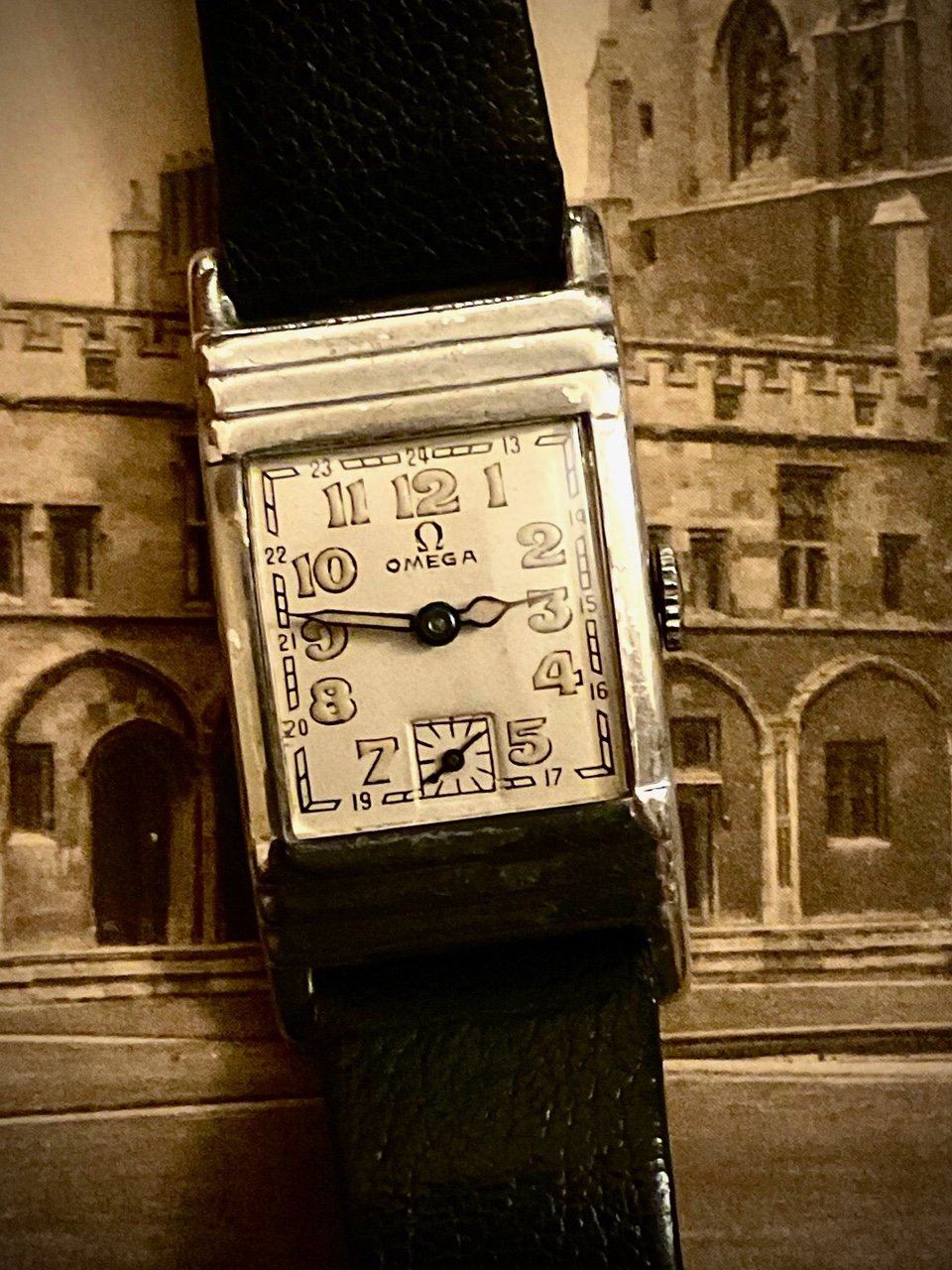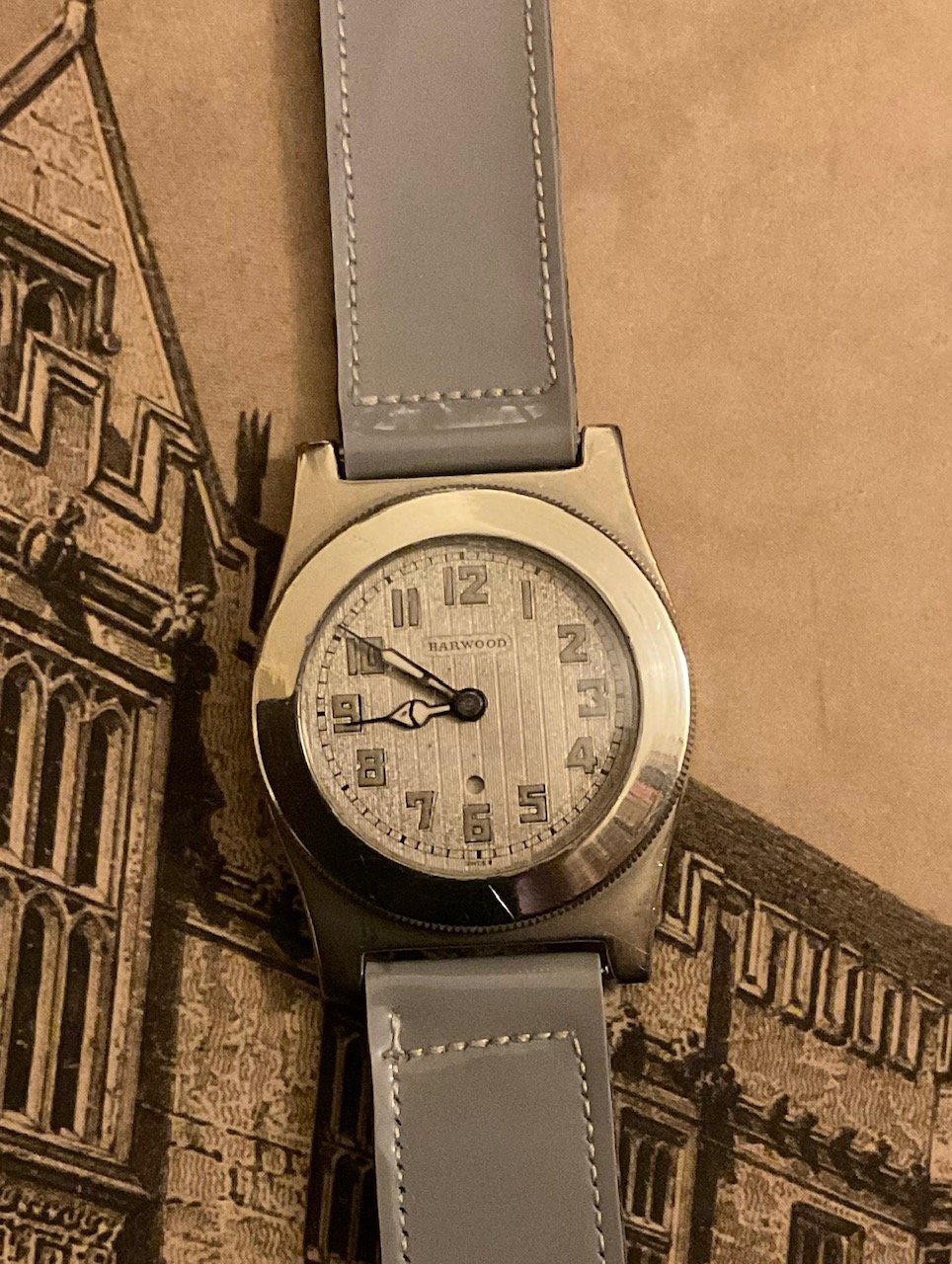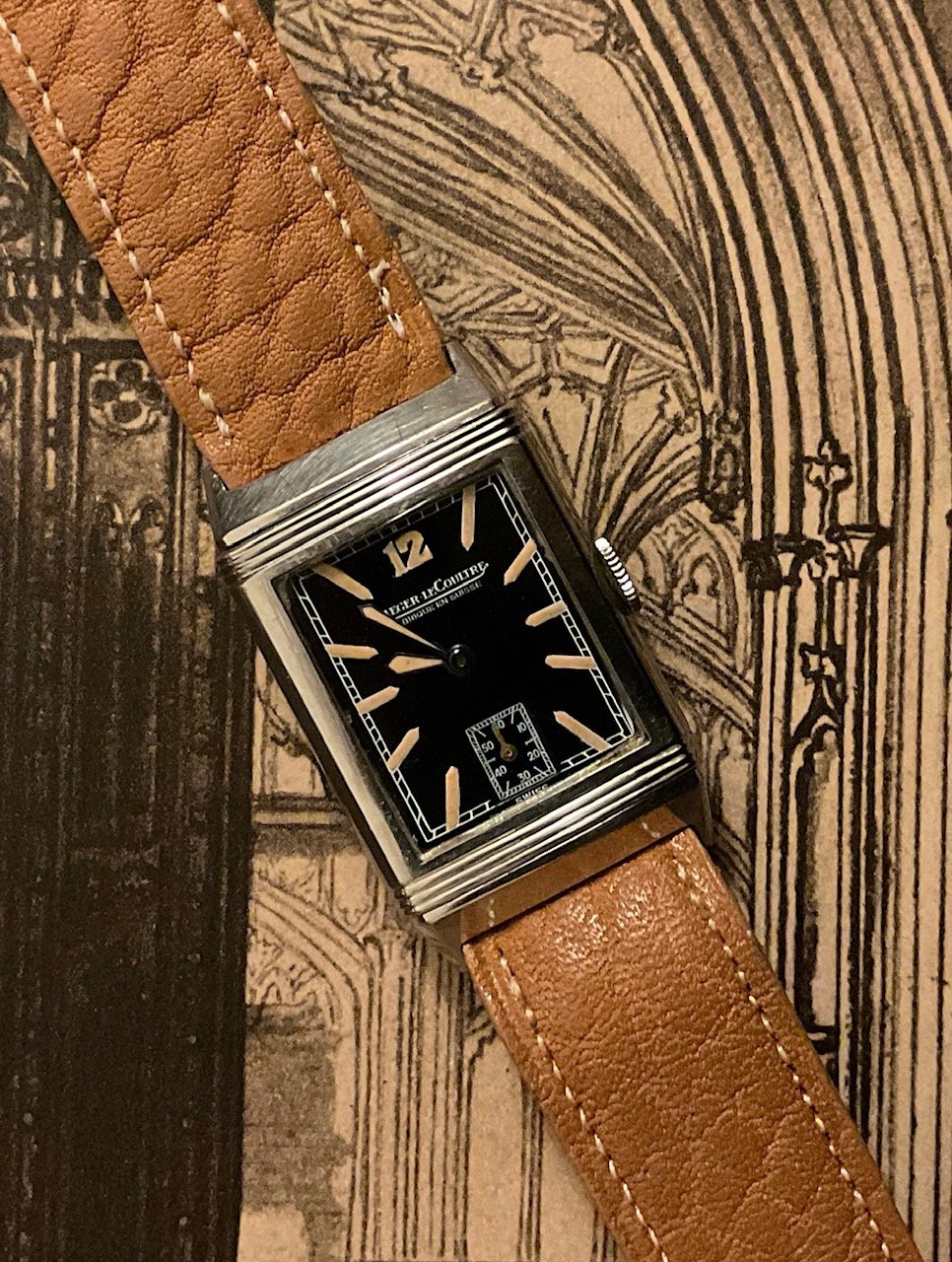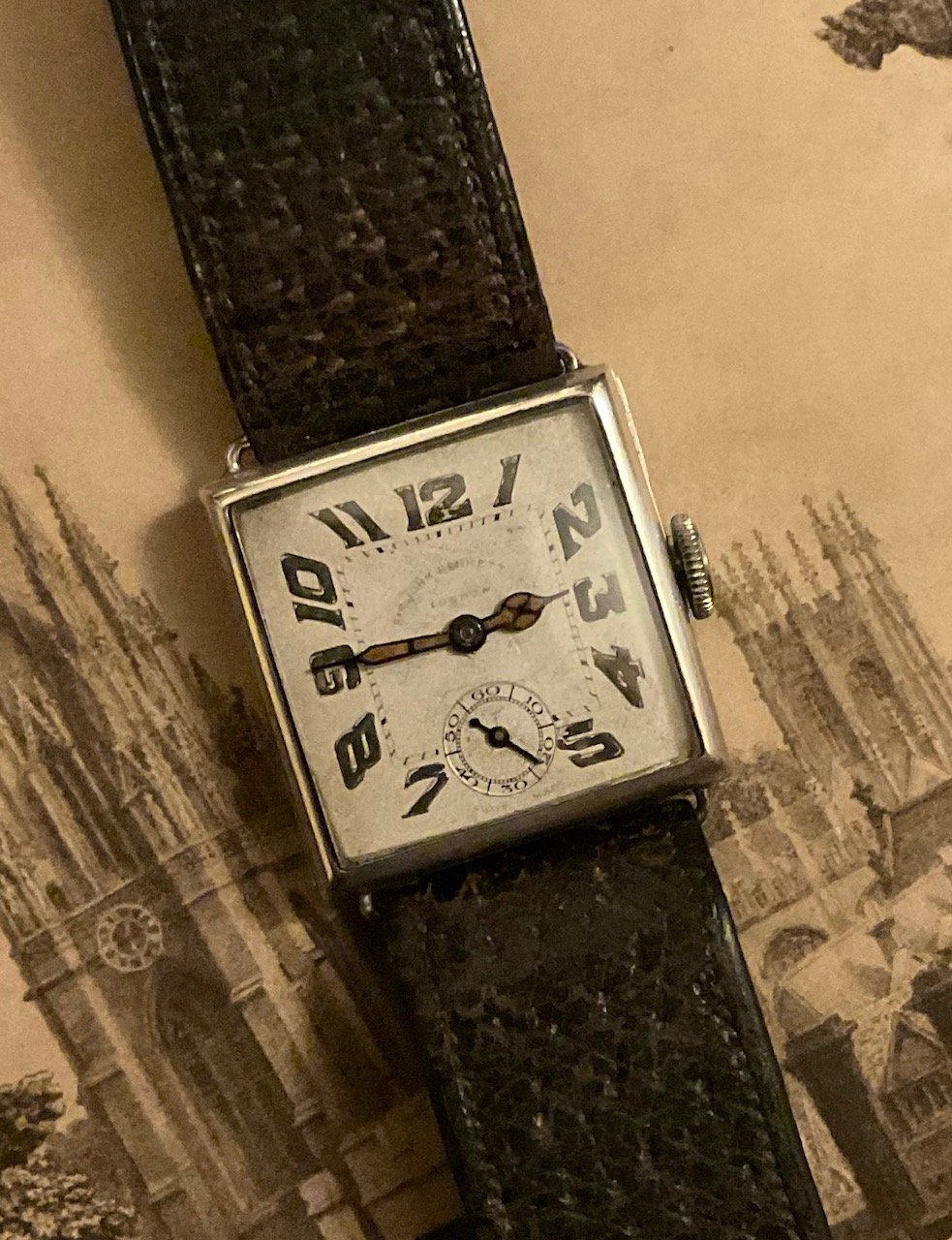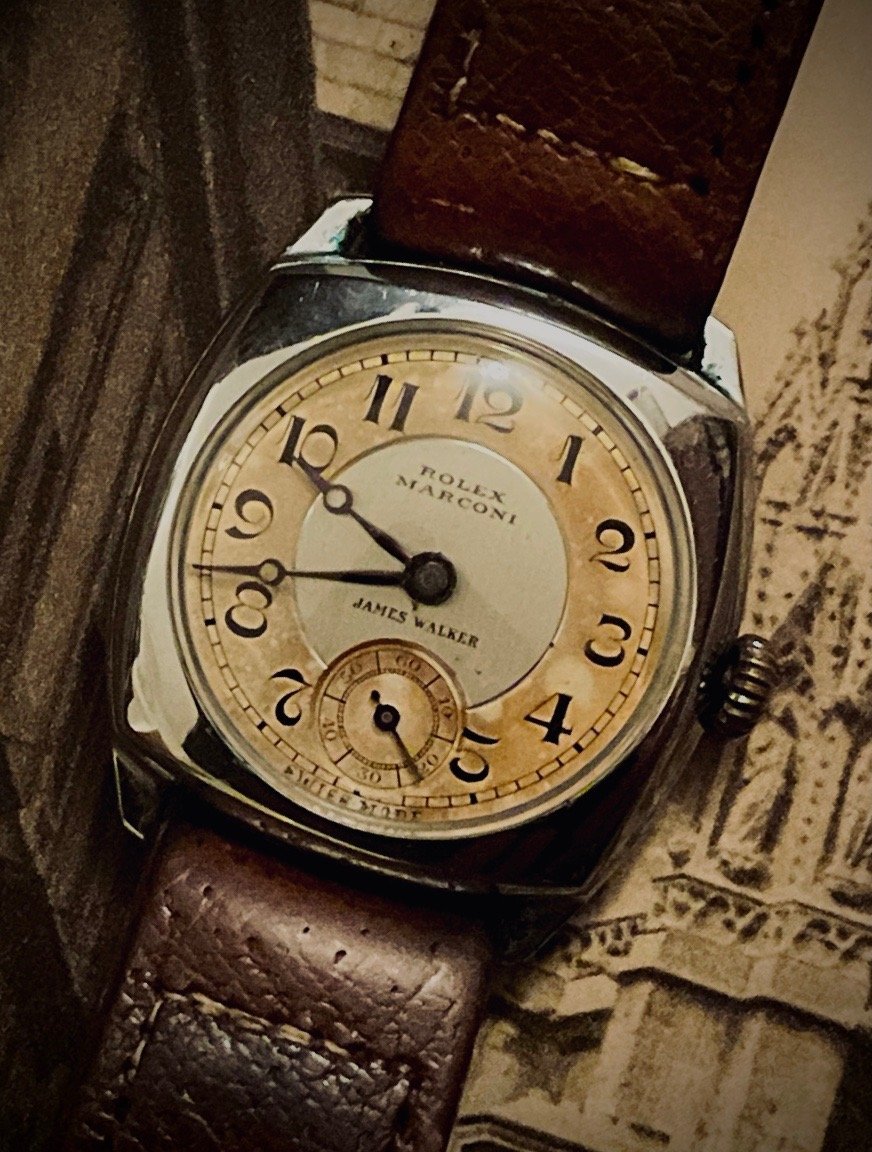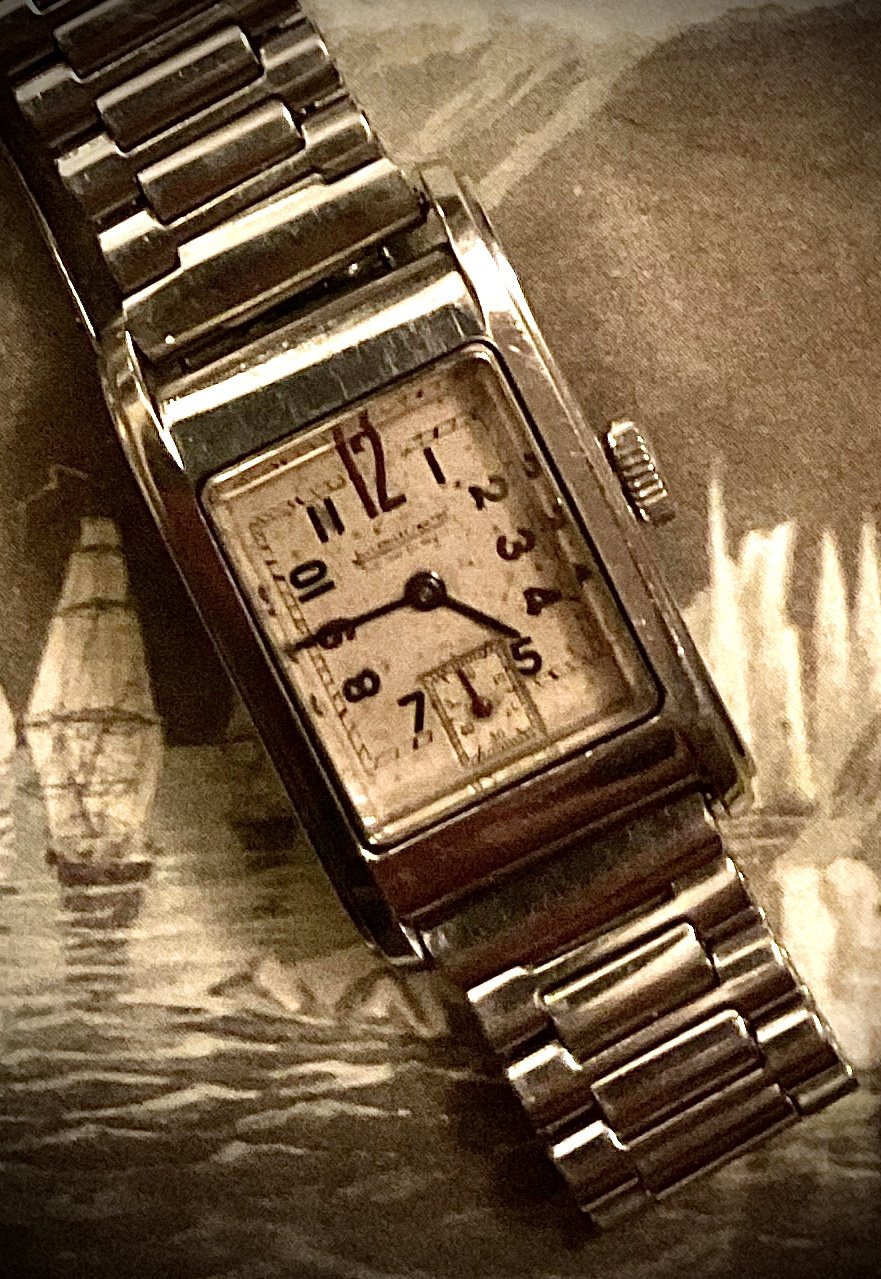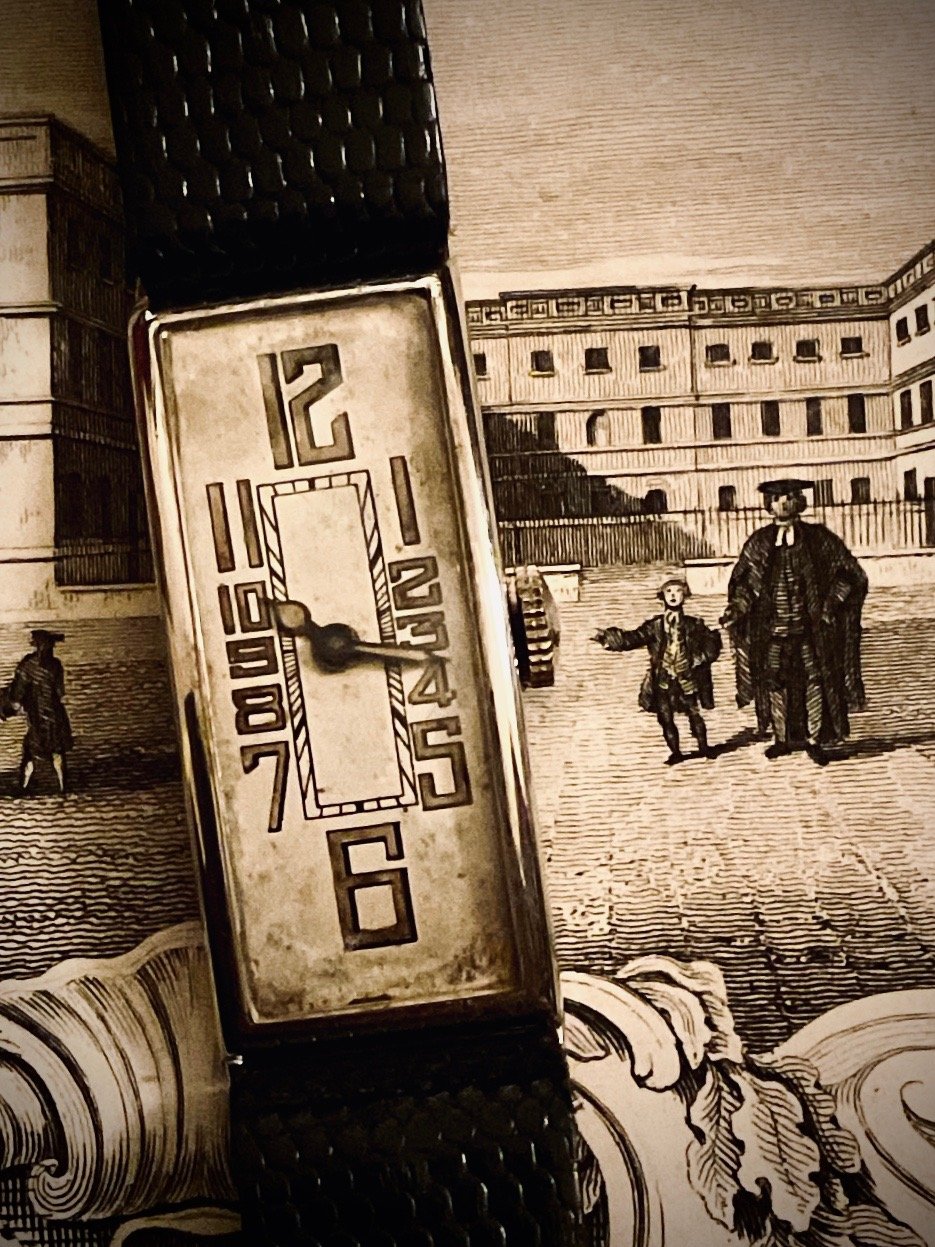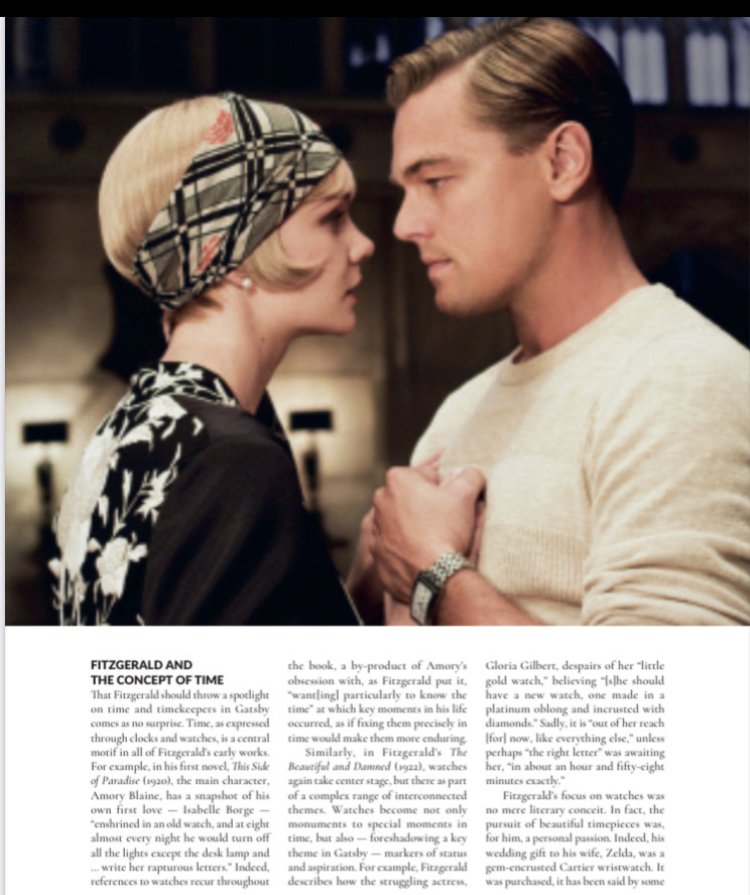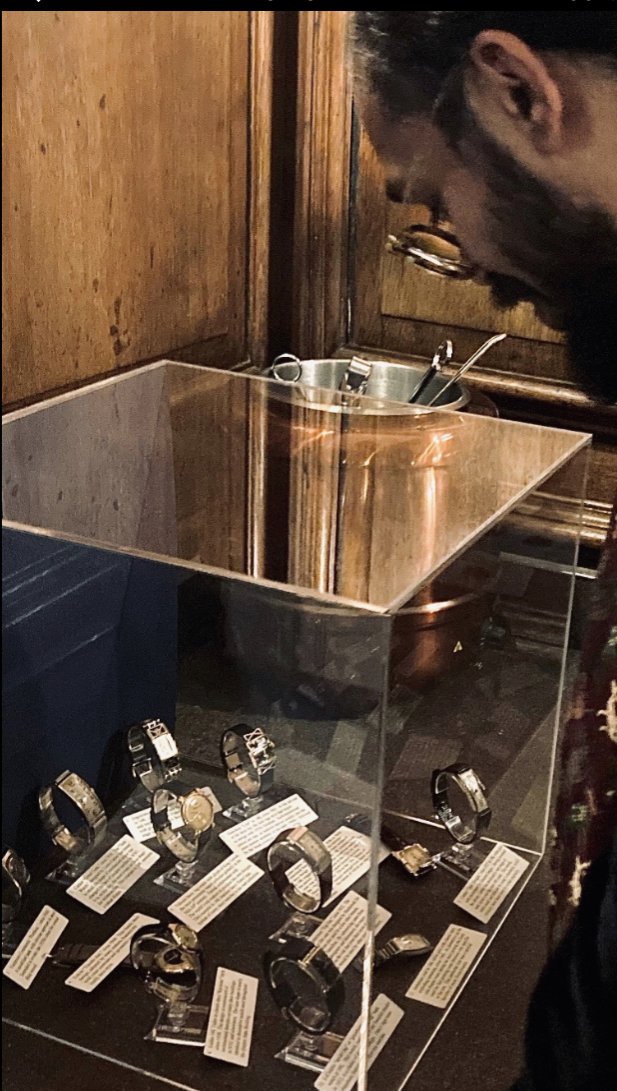Watches of the Gatsby Era
An Exhibition at Trinity College, Oxford (UK) & The Explorers Club (USA)
“Gatsby’s head leaned back so far that it rested against the face of a defunct mantelpiece clock, and from this position his distraught eyes stared down at Daisy, who was sitting, frightened but graceful, on the edge of a stiff chair.
Luckily the clock took this moment to tilt dangerously at the pressure of his head, whereupon he turned and caught it with trembling fingers and set it back in place.
‘I’m sorry about the clock,’ he said.
‘It’s an old clock,’ I told them idiotically.
I think we all believed for a moment that it had smashed in pieces on the floor.”
2025 is chockablock with cultural milestones: the centennials of movies (well, talkies anyway), the iconic VW Beetle, and Snoopy. But none of these anniversaries speaks more powerfully to the spirit of the era that it recalls—the Jazz Age of the Roaring ‘20s—than the 100th birthday of F. Scott Fitzgerald’s The Great Gatsby. Gatsby’s celebration of unabashed greed, social ambition, and nostalgia for lost days that never were plucks all the strings that collectively define the American character. The novel is, as they say, timeless.
And time, without question, is the essence of Gatsby. The broken mantelpiece clock—stopped precisely at ten ‘til two—that Gatsby knocks over during that first tense encounter with Daisy after five long years, becomes a powerful symbol in Fitzgerald’s book. It represents simultaneously the relentless passage of time set against Gatsby’s inability to move forward in his own life. More specifically, it recalls the idylls of his youthful romance with Daisy while, at the same time, underscores the extent to which the war-years had utterly transformed the world—and the lives of most everyone in it. Like any timepiece, it balances eternity and mortality in precisely, if paradoxically, equal shares.
Fitzgerald’s Timepieces
That Fitzgerald should throw a spotlight on time and timekeepers in Gatsby comes as no surprise. Time, as expressed through clocks and watches, is a central motif in all of Fitzgerald’s early works. For example, in his first novel, This Side of Paradise (1920), the main character, Amory Blaine, has a snapshot of his own first love—Isabelle Borge—“enshrined in an old watch, and at eight almost every night he would turn off all the lights except the desk lamp and . . . write her rapturous letters.” Indeed, references to watches recur throughout the book, a byproduct of Amory’s obsession with, as Fitzgerald put it, “want[ing] particularly to know the time” at which key moments in his life occurred, as if fixing them precisely in time would make them more enduring.
Similarly, in Fitzgerald’s The Beautiful and Damned (1922), watches again take center stage, but there as part of a complex range of interconnected themes. Watches become both monuments to special moments in time, but also—foreshadowing a key theme in Gatsby—markers of status and aspiration. For example, Fitzgerald describes how struggling actress, Gloria Gilbert, despairs of her “little gold watch,” believing “[s]he should have a new watch, one made in a platinum oblong and incrusted with diamonds.” Sadly, it is “out of her reach [for] now, like everything else,” unless perhaps “the right letter” was awaiting her, “in about an hour and fifty-eight minutes exactly.”
Fitzgerald’s focus on watches was no mere literary conceit. In fact, the pursuit of beautiful timepieces was, for him, a personal passion. Indeed, his wedding gift to his wife, Zelda, was a gem-encrusted Cartier wristwatch. It was purchased, it has been said by some literary historians, with the proceeds from his then just-published This Side of Paradise. However, the record discloses an alternative explanation for Fitzgerald’s largesse—a watch caper that would warm the heart of any aficion. In April 1920—the same month he was married—Fitzgerald published “The Camel’s Back,” a short story that would later be anthologized (along with “The Curious Case of Benjamin Button”) in Tales from the Jazz Age (1922). About that endeavor, Fitzgerald wrote:
“[O]f all the stories I have ever written this one cost me the least travail and perhaps gave me the most amusement. As to the labor involved, it was written during one day in the city of New Orleans, with the express purpose of buying a platinum and diamond wrist watch which cost six hundred dollars. I began it at seven in the morning and finished it at two o’clock the same night. It was published in the Saturday Evening Post.”
Was that Zelda’s wedding watch or another timepiece? The jury is still out. Either way, along with John Lennon’s Patek perpetual calendar and Buzz Aldrin’s space-flown Omega Speedmaster, Zelda’s Cartier must be counted among the world’s great “missing watches.”
Watches of the Jazz Age
So integral to the gilded world of Gatsby were these fabulous watches that the movie versions of the book understandably went heavy on the wristwear. Mia Farrow imitated life in her memorable portrayal pf Daisy by wearing a jeweled Cartier deco dress watch—along with dozens of other outrageous deco jewelry pieces. In the end, the film became a significant fashion moment, reviving an interest in deco that had lain dormant for decades. On the strength of public enthusiasm, Cartier mounted a successful retrospective exhibition at its NYC flagship, displaying a number of deco pieces worn in the film. In the 2013 adaption, Tiffany stepped up to provide all of the fabulous jewelry for the production, including many bespoke pieces. And while internet pundits have pegged Mr DiCaprio’s steel tank (he played the title role) as a JLC Reverso, close inspection reveals it to be one of Tiffany’s own in-house tanks. Great watches all around.
To be sure, Fitzgerald’s fascination with haute horlogerie did not come out of nowhere. For watches and watchmaking, the 1920s were a crucially important decade. The new trend toward men’s wristwatches, as opposed to traditional pocket watches, ushered in by World War 1 had crystallized into a vibrant international market for men’s fashion timepieces. The same war had also created a generation of women with new feminine aesthetics that included a place for beauty of a robust and functional kind, alongside an enthusiasm for the delicate and the decadent. The jewelers of the day were only too happy to adapt to these changing tastes.
Style cues ultimately came from many sources. The timepieces on display at the 1925 Exposition des Arts Décoratifs in Paris, widely regarded as the defining moment in the development of the art-deco aesthetic, emphasized the merger of form and function. News events played a role, too. The discovery of King Tut’s tomb in 1922 informed Jazz Age jewelry tastes in a variety of ways. The geometric shapes, colored stones, and shiny enamels that archaeologists had pulled from the desert were echoed strongly in watch designs of the period. This influence is especially obvious in Cartier’s colored gem creations—its so-called “tutti frutti” line. Cartier’s most memorable—and most exotic—case shapes, the Cloche and the Cintrée, also date from this period.
In tandem with this evolution in style were important technical innovations. Indeed, some of the most significant horological milestones in history date to this very special decade. The original Rolex “Submarine” watches, the first true waterproof designs, date to the early 1920s—and the firm’s legendary Oyster case was officially launched just a few years later in 1926. As for complications, 1923 saw the launch of Patek Philippe’s first split-seconds chronograph wristwatch and, two years later, their first perpetual calendar wristwatch. Also notable was LeCoultre’s 101 movement of 1929—still the smallest mechanical movement ever produced. It was an achievement that has never been exceeded.
New York Style
In addition to these larger industry trends, Fitzgerald would also have had significant local inspiration for his love of watches. For example, Louis Comfort Tiffany was a prominent part of his NYC social set. More broadly, however, the New York of Fitzgerald—and, more to the point, the New York of Jay Gatsby—was, in that great capital of fashion and finance, the age of bespoke jewelry. Forgotten names like Maurice Dreicer and Herman Marcus competed—and frequently bested—better remembered names like LC Tiffany and Pierre Cartier. The rivalries were fierce, particularly between Dreicer and Cartier, who routinely rebranded or copied each other’s signature pieces. Jewelry watches were a significant part of the output of these great luxury houses, with much of the case design and construction carried out locally, reflecting NYC’s own distinctive aesthetic.
This local flavor only intensified as the decade wore on, especially once the US Congress passed the Smoot-Hawley Tariff Act of 1930. Although not especially a target of the legislation, Swiss watches were hit hard by the tariffs nonetheless. The new economic reality compelled the great Swiss manufactures to seek out local representatives and collaborators. Shipping raw movements and leaving casing entirely to the discretion of their local NYC agents—and so avoiding the bulk of the high tariffs—provided a recipe for success that endured for more than thirty years. While lower Manhattan had always played host to a small cadre of independent jewelers—and indeed Marcus and Dreicer had emerged from that world—suddenly Maiden Lane and lower Wall Street became home to dozens, eventually more than a hundred, case makers with largely forgotten names like Brooklyn Watch, Crescent, Courvoisier-Wilcox, Max Freund & Co., Henry Goll, Leon Hirsch, Edwin North, Jeannot & Shiebler, Ollendorf, Roy Watch Co., Smith & North and Roseman & Levy. These firms sat alongside somewhat better-remembered names like Fahys, Peerless & the American Watch Co. Some firms, such as Di Vincenzo & Arienti, who made bespoke contract cases for Rolex (among others), soldiered on into the early 1960s.
The impact of these local craftsmen on the style and diversity of the watches from NYC’s deco period (and beyond) cannot be overstated. Collectors of Vacheron, Le Coultre, Longines, Omega and many other brands often applaud these manufactures for their bold case designs—and for the small batches in which these watches were made during the ‘20s, ‘30s and ‘40s. Both factors hold strong appeal for the collector. The brands, however, can claim little of the credit for these extraordinary and memorable watches which were, in truth, the artistic output of those tiny, forgotten workshops along Maiden Lane.
Awareness of this corner of horological history has grown just a little in recent years. This same phenomenon played out in Switzerland during the 30s, 40s and 50s. The best Swiss case designers—Markowski (who is credited with designing the famous Patek “Top Hat”), Wenger, and Vichet—are now sometimes referenced in auction essays to add uniqueness and enhance the value of a piece. However, the “lost designers of Maiden Lane” have yet to receive even that modest quantum of recognition. A new exhibition this spring aims to change that. “Watches of the Gatsby Era,” featuring one hundred timepieces from the deco age will go on display in the UK and USA from March 25th, 2025.
“Watches of the Gatsby Era” Exhibition
On the UK side, all currently scheduled events will take place at the University of Oxford with which Gatsby has a strong association. Jay Gatsby, after serving in World War I, enrolled at Trinity College, Oxford in 1919. According to college records, four demobbed American officers did, in fact, enroll at Trinity that year. The exhibition will include archival photographs taken by one of these extraordinary young men, just months removed from the trenches. Also on display will be bibliophilic materials connected with the first publication of The Great Gatsby. And, finally, the watch collection, representative of the era, will be available for viewing. The Oxford installation will include a special exhibition, reception, and program of public lectures on April 10th, 2025, the exact centenary of the publication of Fitzgerald’s masterpiece. On the US side, all events will take place in New York City in collaboration with Adam Victor of the Monaco Legend Group and Paul Boutros of Phillips and will include an exhibition, lecture and reception at the Explorers Club in mid-May, exact date TBA. Consult www.IDAwarches.org for more details.
Like every great book, Gatsby has been appreciated in different ways at different times. During the Depression, the book provided escapist nostalgia for a prior decade steeped in absent luxury. In the 1940s, Gatsby’s fortunes were buoyed by USO programs that put tens of thousands of copies of the book into the hands of restless troops overseas. In 1951, Gatsby got a boost from a celebrity endorser: Holden Caufield. Salinger’s hero famously declares: “I was crazy about The Great Gatsby. Old Gatsby. Old sport. That killed me.” (It is perhaps worth noting that Salinger’s daughter, was, like Gatsby, a student at Trinity, Oxford.) In the 60s and 70s, Jay Gatsby became a counter-culture icon on the strength of his brooding melancholy and mod wardrobe. In the 80s, he was the embodiment of Jay McInerney’s epoch-defining Tad Allagash of Bright Lights, Big City. Over the last few decades, Gatsby has settled into a cozy niche, alongside To Kill a Mockingbird and Slaughterhouse-Five, as a chiseled bust in the American literary pantheon. Perhaps the advent of the Trump era will land Gatsby a new role on the veranda of Mar-a-Lago? Come to the exhibition and find out.
